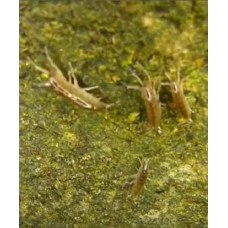Division Foot crabs, subclass Higher crabs (Malacostraca). The body length is usually 1-2 cm. The body of most is laterally compressed. The first two pairs of thoracic legs are clawed. The remaining 5 pairs of pectoral legs are used for crawling and climbing. All 7 pairs of pectoral legs have gills. The abdomen has three pairs of swimming legs and three pairs of hopping legs. Reproduction is sexual. More than 9,900 species have been described. They are mainly marine but occur in almost all aquatic environments. About 1,900 species live in fresh water. Amphipods play an important role in the diet of fish.
The name Amphipoda is derived from the Greek roots ἀμφί 'on both sides' and πούς 'foot'. This contrasts with the related isopods, which have a single type of thoracic leg. Among anglers, amphipods are known as freshwater prawns, scads or sidskimmers.
The body of an amphipod is divided into 13 segments, which can be grouped into head, thorax and abdomen. The head is fused to the thorax and has two pairs of antennae and a pair of sessile compound eyes. It also has mouthparts, but these are usually hidden. The thorax and abdomen are usually quite distinct and have different types of legs; they are usually compressed from the sides and lack a carapace. The thorax has eight pairs of single-toothed appendages, the first of which are used as auxiliary mouthparts; the next four pairs point forward and the last three pairs point backwards. Gills are present on the thoracic segments and there is an open circulatory system with the heart using haemocyanin to deliver oxygen from the haemolymph to the tissues. Salt absorption and excretion is controlled by special glands on the antennae. The abdomen is divided into two parts: the pleosoma, which carries the swimming legs, and the urosoma, which consists of a telson and three pairs of uropods that do not form a tail fan as in animals such as true shrimps.
Amphipods are usually less than 10 millimetres (0.4 inches) long, but the largest recorded living amphipod reached 28 centimetres (11 inches) in length and was photographed at a depth of 5,300 metres (17,400 feet) in the Pacific Ocean. Specimens recovered from the stomach of a black-footed albatross had a reconstructed length of 34 centimetres (13 inches) and were attributed to the same species, Alicella gigantea. Other specimens of A. gigantea, the largest of which was estimated to be 34.9 cm (12 in) long, were found during the Kermadec Trench survey, and some were collected for study, the largest of which was measured to be 27.8 cm (12 in) long. The smallest known amphipods are less than 1 millimetre (0.04 inches) long. Amphipod size is limited by the availability of dissolved oxygen, so amphipods in Lake Titicaca at 12,500 feet (3,800 metres) can grow to only 22 millimetres (0.87 inches), compared to 90 millimetres (3.5 inches) in Lake Baikal at 1,500 feet (455 metres).
Amphipods engage in amplexus, a pre-copulatory guarding behaviour in which males grab the female with their gnathopods (enlarged appendages used for feeding) and carry the female pressed against their abdominal surface. Reproduction can last from two to over fifteen days, depending on water temperature, and ends when the female molts, after which her eggs are ready for fertilisation. Mature females produce a marsupial, or brood sack, which holds their eggs from the time of fertilisation until the calves are ready to hatch. As the female ages, she produces more eggs in each brood. Egg mortality is around 25-50%. They have no larval stages; the juvenile form hatches directly from the eggs and sexual maturity is usually reached after 6 moults. Some species are known to eat their own secretions after molting. Some amphipods are sexually dimorphic. In dimorphic species, males are usually larger than females, although in the genus Crangonyx the situation is reversed.
There are currently more than 10,500 known species of amphipods. Traditionally, they have been divided into four suborders: Gammaridea, Caprellidea, Hyperiidea and Ingolfiellidea. The suborder Gammaridea contained the largest number of taxa, including all freshwater and terrestrial species. In contrast, the small suborder Ingolfiellidea contained only 40 species.
Most amphipods are pests or scavengers, some feed on algae, are omnivorous or prey on small insects and crustaceans. They grasp food with their two pairs of front legs, which are armed with large claws. The more immobile amphipod species eat larger quantities of less nutritious food rather than actively seeking out more nutritious food. This is a form of compensatory feeding. This behaviour may have evolved to minimise the risk of predation when searching for other food. The incidence of cannibalism and predation within the herd is relatively high in some species, although adults may reduce cannibalistic behaviour towards young when they are likely to encounter their own offspring. In addition to age, sex also appears to influence cannibalism, with males feeding less on recently moulted females than males.
Amphipoda
Tags: Amphipoda




